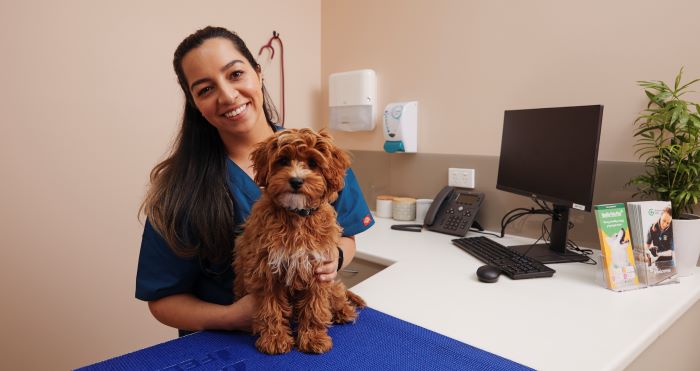Canine parvovirus, commonly called “parvo” is a highly contagious viral illness that poses a serious threat to dogs, especially puppies under 6 months of age.

Read on to learn how canine parvovirus is transmitted and how you can protect your dog from this deadly disease.
What is canine parvovirus?
Canine parvovirus is a highly contagious, resilient virus that primarily targets the gastrointestinal tract of dogs and sometimes the cardiovascular system.
The more common form is the gastrointestinal form. It attacks a dog’s intestines lining and bone marrow. The virus’s effect on bone marrow means the dog can’t produce enough white blood cells to fight off infections.
The cardiovascular form is less common and attacks the heart muscles of very young puppies.
How do dogs contract parvovirus?
Parvovirus spreads through direct contact with infected dogs or their faeces. It is important to understand that your dog doesn’t need to come into direct contact with another dog to become infected with parvovirus.
Common modes of transmission include:
- Direct contact: Dogs can contract parvovirus by interacting with infected dogs at parks, kennels, or other communal areas.
- Contaminated surfaces: The virus can survive on surfaces such as food bowls, toys, and bedding, as well as the ground in parks and yards. Dogs can become infected by licking or sniffing these contaminated items.
- Faecal-oral route: Dogs ingest the virus when they come in contact with infected faeces. This can happen during walks or when exploring outdoor spaces.
The virus can survive in the environment for months, making it a significant concern for dog owners and breeders. The virus can withstand routine cleaning and changes in the weather, meaning the spread of the virus is hard to control.
What dogs are considered high risk for parvovirus?
While all dogs are susceptible to parvovirus, certain groups are at higher risk:
- Young puppies (typically between 6 weeks and 6 months old) are particularly vulnerable due to their immature immune systems.
- Unvaccinated dogs that haven’t received their full vaccination series are more likely to contract parvovirus.

What are the Symptoms of Canine Parvovirus?
Recognising the symptoms of parvovirus early is crucial for timely intervention. Common signs of parvovirus include:
- Severe vomiting
- Bloody diarrhoea
- Lethargy
- Loss of Appetite
- Dehydration
Not all symptoms may be present at the same time, particularly during early infection and, sadly, parvovirus symptoms progress rapidly and the disease can be fatal.
What to do if your dog is showing symptoms of parvovirus
If your dog is showing signs of parvovirus, isolate them from other dogs to prevent further spread and contact your veterinarian immediately. Your vet will guide you on the next steps, including diagnostic tests and treatment options.
Make sure you thoroughly disinfect all surfaces your dog has come into contact with to prevent further transmission.
How to prevent parvovirus in dogs
Parvovirus is very serious and can be fatal, with or without treatment, which is why prevention is so important.
The parvovirus vaccine
The parvovirus vaccination is highly effective and vaccinating your dog against parvovirus is the only way to protect them from the disease. Vaccinate your puppy according to your vet’s recommended vaccine schedule and keep up to date with subsequent boosters for the rest of your dog’s life.
Remember, your puppy will not have full immunity against canine parvovirus until two weeks after their final puppy vaccination.
Other parvovirus prevention strategies
- Don’t let your puppy walk in parks and other areas that have heavy dog traffic until two weeks after their final puppy vaccine.
- Limit exposure to high-risk communal areas, such as dog parks, particularly if you have a young or immunocompromised dog.
- Clean food bowls, toys, and bedding regularly to minimise the risk of contamination.
For more information on protecting your pet from parvovirus and other contagious diseases, contact your local Greencross Vets.


